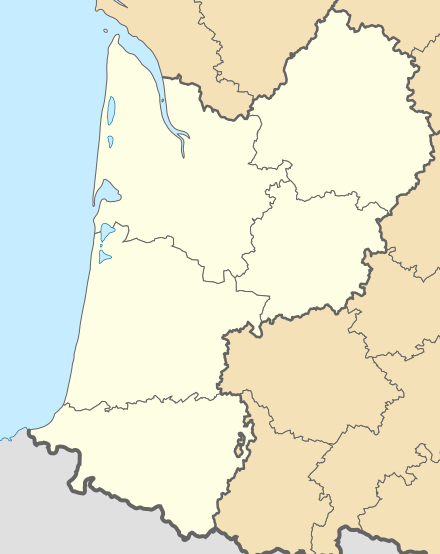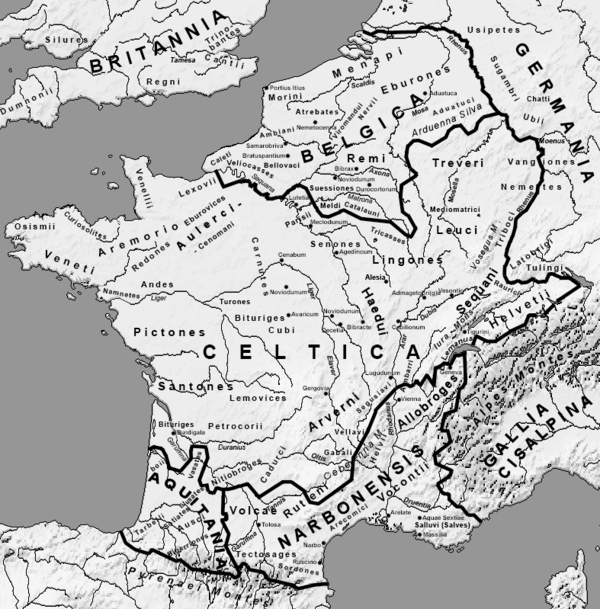" Occupied by humans for at least 55,000 years, it is also the cradle of the Pouilly-Fuissé wine appellation. "
https://en.wikipedia.org/wiki/Rock_of_Solutr%C3%A9
"The height of the sites in relation to the flood plain was the most important factor for human habitation. Providing shelter and food for migrant groups, the foot of the rock, strewn with debris, afforded hunters the opportunity to develop traps.
The bone-laden magma can be explained by the fact that the site was used by four great paleolithic civilizations over the 25,000 years from 35,000 to 10,000 B.C, an extremely long time period."
"The use of this site was therefore devoted to hunting activity, butchering and smoking meat, while the neighbouring Rock of Vergisson was a site for habitation.
The material found at Solutré was therefore linked with hunting; many tools were found including the flints cut in the shape of bay leaves which are characteristic of Solutrean culture."
"The Solutrean hypothesis argues that people from Europe may have been among the earliest settlers of the Americas.
The Solutrean hypothesis posits that about 21,000 years ago a group of people from the Solutré region of France, who are characterized historically by their unique lithic technique, migrated to North America along pack ice in the Atlantic Ocean.
Once they made it to North America, their lithic technique dispersed around the continent (c. 13,000 years ago) to provide the basis for the later popularization of Clovis lithic technology. The premise of the Solutrean Hypothesis is that the similarities between Clovis and Solutrean lithic technologies are evidence that the Solutreans were the first people to migrate to the Americas, dating long before mainstream scientific theories of the peopling of the Americas.
Its notable recent proponents include Dennis Stanford of the Smithsonian Institution and Bruce Bradley of the University of Exeter"
https://en.wikipedia.org/wiki/Solutrean_hypothesis
" 2014, the autosomal DNA of a male infant (Anzick-1) from a 12,500-year-old deposit in Montana was sequenced. The skeleton was found in close association with several Clovis artifacts.
"The hypothesis is challenged by the large gaps in time between the Clovis culture and Solutrean eras, a lack of evidence of Solutrean seafaring, lack of specific Solutrean features and tools in Clovis technology, the difficulties of the route"
"Solutrean tool-making employed techniques not done before and not rediscovered for millennia, distinguishing the Solutrean technique as far ahead of its time. Also, the Solutrean toolmaking industry disappeared from Europe around 17,000 years ago to be replaced by the Magdalenian bone and flint-based industry, which were less effective than the Solutrean tools."
"Stanford and Bradley's 2012 book Across Atlantic Ice: The Origin of America's Clovis Culture expands upon and revises earlier formulations of the Solutrean Hypothesis. The book received significant media attention, but evaluations of the evidence by professional archaeologists find the book unconvincing. "
"X2a has not been found anywhere in Eurasia, and phylogeography gives us no compelling reason to think it is more likely to come from Europe than from Siberia. Furthermore, analysis of the complete genome of
Kennewick Man, who belongs to the most basal lineage of X2a yet identified, gives no indication of recent European ancestry
and moves the location of the deepest branch of X2a to the West Coast, consistent with X2a belonging to the same ancestral population as the other founder mitochondrial haplogroups. Nor have any high-resolution studies of genome-wide data from Native American populations yielded any evidence of Pleistocene European ancestry or trans-Atlantic gene flow"
"In 1970 a stone tool, a biface hand axe, which was later suggested by Stanford and Bailey to resemble Solutrean stone tools, was dredged up by the trawler Cinmar off the east coast of Virginia in an area that would have been dry land prior to the rising sea levels of the Late Pleistocene. The tool was allegedly found in the same dredge load that contained a mastodon's remains. The mastodon tusks were later dated at 22,000 years old"
"carved piece of bone depicting a mammoth found near the Vero man site in Florida was dated between 20,000 and 13,000 BP.
It is described as possibly being the oldest art object yet found in the Americas. Art historian Barbara Olins has compared the Vero carving to "Franco-Cantabrian" drawings and engravings of mammoths. She notes that the San of southern Africa developed a realistic manner of representing animals similar to the "Franco-Cantabrian" style, indicating that such a style could have evolved in North America independently"
'Similar to the controversy surrounding Kennewick Man, the Solutrean hypothesis also became politicized during the 2010s. Reports claimed that it had attracted the support of white supremacist groups, who interpreted the theory to say that the "original inhabitants of the Americas" were "white Europeans" (disregarding the fact that the
Solutreans were likely brown-skinned and the present-day Native Americans are the descendants of "later immigrants" from Asia."
"An episode of the Canadian Broadcasting Corporation documentary The Nature of Things in January 2018 was widely criticized by scientists and Native Americans for its uncritical presentation of the Solutrean hypothesis. "
https://en.wikipedia.org/wiki/Vero_man
Recent studies show that, in fact, the Vero human bones are from the Pleistocene.
They now are recognized as the largest collection of human remains from the Pleistocene found in North America.
Human bones, artifacts, and/or human-modified animal bones in a Pleistocene context now have been found elsewhere in Florida, including at the nearby Helen Blazes and Melbourne Bone Bed sites.
The Old Vero Ice Age Sites Committee announced the discovery of a possible "human living surface" at least 12,000 years old during the 2014 excavation season. Excavations continued into 2015 at the site, with finds including 14,000 year-old charred bones from both a dire wolf and a horse, possibly from a hearth."
Soule
(French pronunciation: [sul]; Basque: Zuberoa; Zuberoan/ Soule Basque: Xiberoa or Xiberua; Occitan: Sola)
is a former viscounty and French province and part of the present-day Pyrénées-Atlantiques département.
"The territory was already inhabited in the Middle Paleolithic; Neanderthal prehistoric settlements have been found in the caves of Xaxixiloaga in Aussurucq and Etxeberri.
At the end of the Neolithic the population had extended and assimilated knowledge from other peoples. There are protohistoric settlements that show a simple material life and a lifestyle dominated by migration."
"The territory is named Xiberoa in Souletin Basque, Zuberoa in standard Basque, Sola in Gascon and Soule in French; all of them derivate from Subola, the previous name of the region attested for the first time in the year 635 in the diaries of a Franco-Burgundian expedition led by Duke Arnebert against the Basques. "
"Subola comes from the name the Romans gave to the Aquitani tribe that inhabited the region by the time of their arrival, the Suburates, also called Sibusates by Julius Caesar. "
"In the year 1152 Eleanor of Aquitaine married Henry II of England, and thus the Duchy of Aquitaine joined the Crown of England. In 1261, after ten years of conflict, the last viscount of Soule, Auger III, surrendered the castle of Mauléon to Edward I of England, and as a result the territory of Soule was administered by the crown of England. At this time the current network of roads between the Souletin villages was constructed. "
"The English Soule was under the direct authority of the Duke of Aquitaine, who was also the King of England. Control over the territory was delegated to a lord, who kept the castle of Mauléon and collected the taxes. The lord of Soule had fourteen captains, of whom only one was English, the rest being either locally-born or Gascons "
"The Hundred Years' War kept Soule isolated from the exterior for many years. Finally, in 1449, an army led by Gaston IV, the Count of Foix and Viscount of Béarn, took possession of the castle in the name of the French king ending the English presence in Soule. "
"the mid 15th century, Soule finally recognizes the King of France as its own, with the Basque district becoming the smallest province and exclave of the kingdom and the most distant from the centre of power, Paris. "
https://en.wikipedia.org/wiki/Soule
___
"Souletin
or Zuberoan (Basque: Zuberera) is the Basque dialect spoken in Soule, France.
Souletin is marked by influences from Occitan (in particular the Béarnese dialect), especially in the lexicon.
Another distinct characteristic is the use of xuka verb forms, a form of address including in
third person verbs the interlocutor marker embedded in the auxiliary verb:
jin da → jin düxü (s/he came → s/he came to you)."
__
"The Isturitz and Oxocelhaya caves (French: Grottes d'Isturitz et d'Oxocelhaya) are an important Paleolithic site where a Neanderthal mandible was found, as well as later modern human finds associated with the Aurignacian, Solutrean and Magdalenian.
They also include cave paintings and bone flutes.
The caves are located in the Gazetelu hill in the Arberoue Valley in the foothills of Pyrenees, in Lower Navarre, a traditional region of the department of Pyrénées-Atlantiques, southwestern France, part of the French Basque Country. "
"Occupation by Neanderthal and Homo sapiens communities extends over a period from 80,000–10,000 years BP,
and continued to be use (perhaps only for burials) until the Roman era. The site is discussed within the context of Franco-Cantabrian prehistory, as among the easternmost decorated caves that extended along the Pyrenees and Cantabrian Mountains. "
'Isturitz Cave: the high cave in the hill, with openings on both sides of the hill.
Oxocelhaya Cave: 20 meters below Isturitz, notable for its calcite concretions.
Erberua Cave: where the Arbéroue stream runs today, with a siphon at each end; not explored until 1973."
"An assegai or assaga is a polearm used for throwing, usually a light spear or javelin made up of a wooden handle with an iron tip."
Novempopulania (Latin for "country of the nine peoples")
was one of the provinces created by Diocletian (Roman emperor from 284 to 305) out of Gallia Aquitania, which was also called Aquitania Tertia.
"Sibyllates or Suburates probably around Soule/Xüberoa and also Saubusse; the same of Cæsar’s Sibuzates/Sibusates"
'At the time of the Roman conquest, Julius Caesar, who defeated them in his campaign in Gaul, describes them as making up a distinct part of Gaul:
All Gaul is divided into three parts, one of which the Belgae inhabit, the Aquitani another, those who in their own language are called Celts, in ours Gauls, the third.
All these differ from each other in language, customs and laws. The river Garonne separates the Gauls from the Aquitani"
___
"George Soule's family may have had Sephardic (Converso) Jewish roots, due to "Sol/Soule" being a common Sephardic name and "Soule" (the version George used in his will) being a Basque province.
Soule's daughter-in-law, Rebecca Simonson, daughter of colonist Moses Simonson, may have had Jewish ancestry, and Soule's printing colleague, Edward "Raban was from a Jewish-descended family in Germany."
George's presumed father Jan Sol, who married as a refugee in 1586 in London, was the grandson of Jan van Sol. This Jan van Sol was a zealous opponent of Anabaptism, which he saw in 1550 as divided into three movements: the Melchiorites (the peaceful Mennonite group), the Davidites, and the Batenburgers.
Jan van Sol was born at Dordrecht, in South Holland, but left the Netherlands in 1530 because of debts (he kept an inn there) and went east to Danzig. There he was known as Johann/Jan Solius (the Latin version of his name).
In 1536 he bought the "Robitten" estate near Bardeyn in East Prussia. He returned in 1550 to Brussels but may have spent his last years, until about 1556, in the territory of Preussisch-Holland. "
On 11 November 1620, Soule and others signed the Mayflower Compact"
https://en.wikipedia.org/wiki/George_Soule_(Mayflower_passenger)








No comments:
Post a Comment